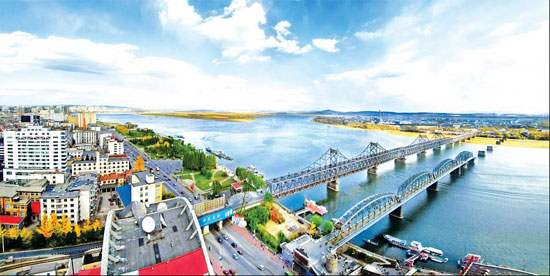Largest border city poised for trade boom
|
Due to the limited traffic volume on the existing cross-border bridge (above) - built alongside an older bridge destroyed during the Korean War, a new Yalu River Bridge (below) is now under way, which, when complete in 2014, will greatly facilitate trade between China and DPRK. |
The recently concluded 2012 China-DPRK Trade, Culture and Tourism Expo, held in Dandong, Liaoning province, has further boosted the thriving transnational trade in China's largest border city.
Despite the global economic slowdown, more than 6,000 business representatives from 20 countries signed agreements on more than 200 cooperative projects. Some 72 of the largest projects have a total combined value of $1.26 billion.
Lu Chao, a researcher at the Liaoning Academy of Social Sciences, explained the reasons behind the success.
"In fact, 2012 has been a difficult year for China's international trade. However, thanks to Liaoning's coastal economic belt development strategy, the construction of the new Yalu River Bridge linking China and the Democratic People's Republic of Korea and the joint development of DPRK's Hwanggumpyong Island, Dandong is offered great opportunities for further opening-up."
The northeastern coastal city of Dandong is the northernmost port along the country's 18,000-kilometer coastline, and it facilitates foreign trade for 13 cities in the eastern part of Northeast China.
Moreover, the city, which faces the DPRK across the Yalu River, has nine trade ports along the 306 km borderline. Connected to the DPRK by highways, railway, pipelines and waterways, Dandong is the main border port connecting China with the Korean peninsula and Eurasia.
With its unique geographic advantage, Dandong is the most vital link in Sino-DPRK trade and business cooperation.
During the 11th Five-Year Plan period (2006-2010), total trade value between Dandong and DPRK amounted to $3 billion. Imports and exports between Dandong and the DPRK reached $1.86 billion in 2011.
So far, trade between Dandong and DPRK accounts for 40 percent of total China-DPRK trade, and the volume of the cross-border cargo trade via Dandong port makes up 80 percent of the total Sino-DPRK trade volume.
Since 2003, when the nation pushed forward a strategy to revitalize the old industrial bases in Northeast China, Dandong has vigorously developed its shipping and port-related industries due to its regional advantage as a port and border city.
Over the past decade, the city's gross domestic product grew from nearly 19 billion yuan in 2002 to almost 89 billion yuan in 2011. Its tax and fee revenues also increased from 1.17 billion yuan in 2002 to 10.38 billion yuan in 2011.
New era
The year 2009 marked a new era for the city's development. That year, Liaoning's provincial coastal economic development strategy was made into a national program. Dandong is the eastern starting point of the province's coastal development belt.
"In that year, the number of foreign delegations we accepted was more than the sum of the past 10 years," said Li Wei, an official at Dandong's foreign economic and trade bureau.
Also, in the past three years, total investment in traffic infrastructure surpassed the sum of the past 50 years. These infrastructure projects included the eastern railway of Northeast China, high-speed railways from Dandong to Dalian and Shenyang, and an expressway from Dandong to Tonghua, Jilin province.
"With two high-speed railways, four expressways, a seaport and an airport, Dandong has become one of the region's hubs of transportation and logistics. Its economic hinterland covers Liaoning, Jilin, Heilongjiang and Inner Mongolia and even extends to all of Northeast Asia, including the DPRK, South Korea, Russia, Mongolia and Japan," Li said.
Moreover, the new Yalu River Bridge is expected to further boost China-DPRK trade and economic cooperation, which will make Dandong a hotspot for investment from all over the world. Many major global names, such as SK and Pohang, and Haman from the US, have established operations there.
Construction on the new bridge, with an investment of 2.22 billion yuan, began at the end of 2011. According to the Dandong government, the main structure of the bridge has been completed. It is expected to become operational in July 2014.
Joint programs
Additionally, China and DPRK have formally initiated joint development programs in DPRK's Hwanggumpyong and Wihwa islands.
Both sides will encourage the development of special economic zones on the two islands under the principles of government-guided, corporate-operated and market-oriented development, and mutual benefits.
According to the Dandong city government, the Hwanggumpyong economic zone will focus on the development of information, tourism, creativity, modern agriculture and apparel processing industries. It will gradually develop into a knowledge-based economic zone.
The authorities of Dandong and their counterparts in DPRK have pledged to make Hwanggumpyong an economic zone with "global influence".
So far, the Sino-DPRK joint management committee of the Hwanggumpyong economic zone has been founded, and some infrastructure on the island is under construction.
"Construction of the bridge and the two island zones will further upgrade Dandong's status as a Sino-DPRK trade hub. It will help strengthen the cooperation between Dandong and DPRK in many fields," Lu said.
According to local authorities, Dandong will use the development of Hwanggumpyong Island as a springboard to boost foreign investment in the city, especially in the areas of research and development, logistics, finance and insurance, exhibitions and conferences, intermediary services, and outsourcing.
Wang Min, Party chief of Liaoning province, also has high hopes for Dandong to become more open.
"Dandong should seize the opportunity and encourage more private companies to play roles in the development of the region, which can inject vitality to local economy," Wang said.
Contact the writers at Zhuchengpei@chinadaily.com.cn



















